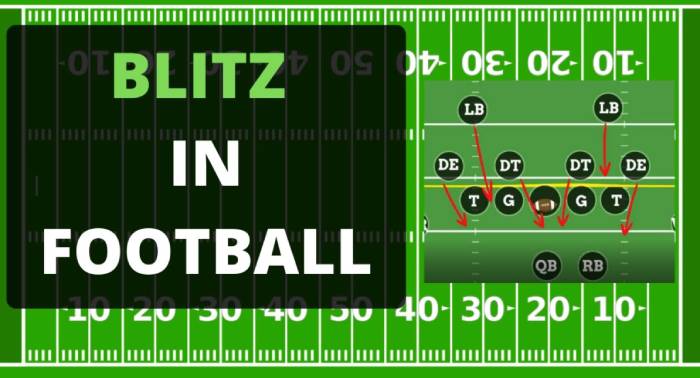In person or on TV, you might see the defense rush the quarterback and either sack him or cause him to throw an incomplete pass due to the rush. Is this type of defensive team play called a blitz? So what is a blitz in football, what are the different formations, and should it be run on every play? Here’s what you need to know!
Table of Contents
What is a Blitz in Football?
A blitz is a defensive play in which five or more defensive players are sent to the line of scrimmage to disrupt the offense. Generally, the goal of a blitz is to sack the quarterback. However, blitzes can still be effective if they disrupt play in other ways, such as forcing an incomplete pass, recovering an interception, or stopping the running back.
Why is it Called a Blitz?
In German, the blitzkrieg means “lightning war.” This translation illustrates how the blitz should appear when attacking the offensive line. A blitzer should strike fast and with impressive force in order to collapse the offense and expose the passer.
Around 1960, Chuck Drulis, the defensive coordinator of the St. Louis Cardinals, called the play a blitz. Adapting the previous well-used “red dog” defensive strategies, he developed his wildcat blitz.
Coaches developed the red-dog play in the late 1940s to create a six-on-five advantage against the offensive line by rushing linebackers. In 1948, Red Ettinger, a linebacker for the University of Kansas, is usually credited with running the first blitz. It wasn’t until ten years later that the term blitz became more popular that these plays were called red-dog plays. The term “dog” is still used by some teams to describe defensive players who rush the line of scrimmage.

What is the Purpose of a Blitz?
An effective blitz can overwhelm the offensive linemen, allowing a linebacker to get through and potentially sack the quarterback. Throughout the game, dominating an offense can have several benefits. Putting pressure on the offense to make passes before the play develops can disrupt the timing of the play. In addition, it can make the quarterback feel insecure in the pocket, making him run and throw poorly.
What are the Different Types of Blitzes?
For different scenarios on the field, a defensive coordinator may have several unique blitz packages in their playbook.
Zone Blitz
This blitz scheme requires some defensive players to drop back to play zone coverage, leaving a linebacker to rush forward and take their place on the line. This play is commonly called a fire zone blitz. Since the quarterback isn’t sure which blockers are rushing and who will cover the field, reading can be difficult. During his time as defensive coordinator for the Cincinnati Bengals in the NFL, Dick LeBeau popularized the zone blitz.
Secondary Blitz
This blitz package involves secondary, safety, and cornerback players coming down to blitz. The offense may misread the play if these players are brought closer to the line of scrimmage. Troy Polamalu is well known for his ability to attack during secondary blitzes for the Pittsburgh Steelers.
Zero Blitz
The blitz package is one of the most risky plays a defense can run, since it leaves no players in the backfield. Unlike a zone blitz, this requires the defensive line to engage in man coverage, focusing on one offensive lineman at a time. It’s usually used when the defense expects a running play.
Can you Blitz Every Play?
Despite its effectiveness, blitzing can be risky due to limited protection against passing plays. Running during every play is difficult due to this little protection. Instead of being a threat to the offense, it can confuse and wear down offensive players throughout the game.
Zone blitzes are used by some defensive coordinators more often than conventional strategies because they allow for some pass coverage if a wide receiver or tight end is open.
Blitzes are designed to put pressure on the quarterback. In spite of this, it’s not the only way to successfully influence the passer. In 2020, the Baltimore Ravens blitzed over 44% of the time, while the Los Angeles Chargers did so only 16% of the time. Despite their blitzing disparities, the Ravens established quarterback pressure about 27% of the time, just slightly more than the Chargers’ 24%. Based on this breakdown, the Chargers could have similar defensive production without having to use blitzes.
While blitzing is an effective tool for putting pressure on the offense, it’s not always the best or most effective. It’s up to the defensive coordinator to determine when to blitz. The goal of any coordinator should be to rush four defensive players because it is the safest option.
Conclusion About the Blitz in Football
The blitz is a defensive scheme in American football where five or more defensive players rush the offense at the start of the play. In general, it leaves the defensive backfield unprotected. However, if done effectively, it can turn the tide of a game by putting pressure on the quarterback.
